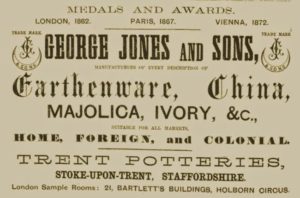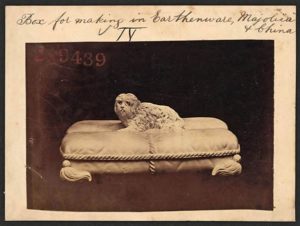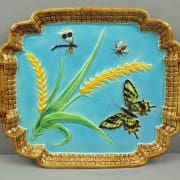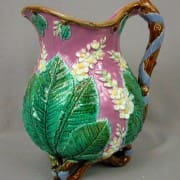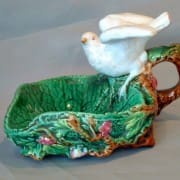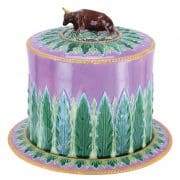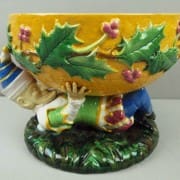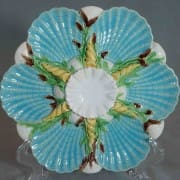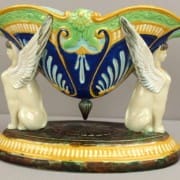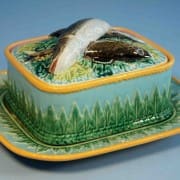George Jones
Majolica produced by George Jones rivals that of Minton and Wedgwood in both design and workmanship. Jones was the youngest of nine children from a family with no connection to the pottery industry. At age fourteen, he commenced a seven year apprenticeship with Minton and upon completion in 1844 worked as a travelling salesman for Wedgwood. Little is known of his output during those years or of any associations he may have had with the renowned modelers of those firms. By 1850 he had established himself as a successful china merchant in Stoke-on-Trent. It was not until 1862 that George Jones entered the pottery manufacturing business with the acquisition of the Bridge works, producing white granite wares. In 1864, Jones purchased parcels of land from Colin Minton Campbell of the Minton factory for construction of the Trent Potteries, which was completed in late 1865. It was in this new and efficient pottery works that George Jones commenced production of majolica in 1866. By 1873 Jones eldest two sons, Frank Ralph and George Henry Jones had become familiar with the business and joined their father in partnership. The firm was retitled George Jones & Sons and the name “Crescent” was registered as the trademark of the new company. At the time, the firm employed 590 skilled workers. Following George Jones’ death in 1893, the family firm saw continued success until the early twentieth century. The company was sold to managing director Walter Bakewell in 1929 and by 1951 the trade name George Jones & Sons was no longer used. The Crescent works was demolished in 1959 after nearly a century of ceramic production.
George Jones won a medal at the Paris Exhibition in 1867 and received acclaim at exhibitions in London (1871), Vienna (1873) and Sydney (1876).
The firm advertised majolica in the Pottery Gazette from 1881 to 1886. Some of our knowledge of George Jones & Sons majolica designs comes from annotated pattern books which have survived and now reside in the Wedgwood Museum.
Fortunately, much of the firm’s majolica production was also marked and the distinctive mottled brown and green undersurface glazing of Jones majolica allows attribution of other unmarked pieces. The firm produced a very large amount of majolica which is still available to collectors. Being of uniformly high quality, the pieces are also among the more expensive.
George Jones produced a broad array of majolica wares. The most successful pattern was likely the Apple Blossom which is sometimes erroneously called Dogwood. The design was adapted to a variety of shapes including small and full-sized cheese keepers, a tea service and graduated pitchers. Calla Lily and Pond Lily patterns were likewise utilized in a number of different shapes. Many pieces are decorated with an ochre twisted rope trim with pointed acanthus leaves. Naturalistic themes predominate, and precisely, but artistically modeled flora and fauna add to the unique charm of George Jones majolica. Among the most prized for collectors are covered dishes including cheese keepers, game pie dishes and sardine boxes. Particularly important is a game pie dish with rabbits molded in relief about the base and the cover decorated with a nesting game bird which forms the handle. The piece was produced both with and without a brood of chicks surrounding the hen. Other covered pieces are festooned with foxes, pastoral cows and water birds. Some successful covered designs were produced in a variety of colors including turquoise, pink and cobalt with complementing interior colors. Also important are a series of fruit compotes composed of a turquoise bowl supported by a gnarled oak trunk, each with different animal figures surrounding the base which were allegorical of the continents. The Victorian whimsical sense of humor is enshrined in the design of a punch bowl produced in several colors with the bowl supported by the supine comedic figure Punch.
Early George Jones majolica was marked with the impressed superimposed letters GJ contained within a circle. In 1873, a crescent inscribed with “& SONS” was added beneath the initials. Many pieces also have a small unglazed area or “thumbprint” which has a pattern number written in black ink. Rarely seen is a raised bilobed cartouche with STOKE ON TRENT below the initials and the pattern number in ink above. Many pieces also bear a British registry mark. Here is a handy majolica date code guide for British registry marks and George Jones date code. Majolica Date Code Guide PDF
External Links:
Photo Credits:
Strawser Auctions
Live Auctioneers
Ebay images
Madelena Antiques
Antiques from Trilogy
Philppe Meunier & Juan-Alonso Defrocourt
Karmason Library



